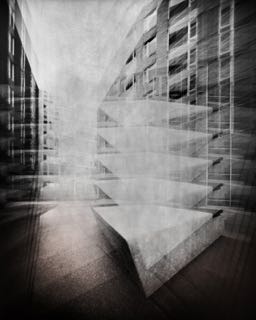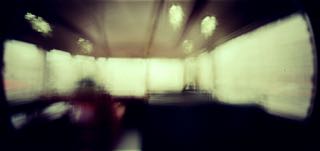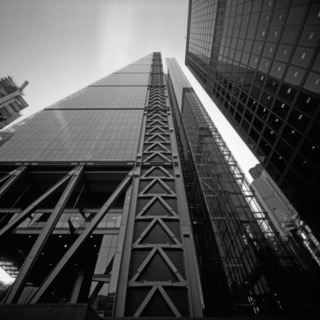It’s not that pinhole photography is a more creative embodiment of photography. It’s that pinhole photography nudges the photographer out on the creative ledge a bit more. Pinhole necessitates experimentation. Constantly infinite depth of field and long exposure times are the first couple steps out towards the ledge. Maybe the realization that one can build their own camera is another step. From there, with a new perspective, experimentation take on a more personal path down that creative ledge.
Last week I posted a 12 part creative challenge. To continue the analogy, that post might be the boot kicking you out there. One of the techniques I encouraged was step exposures – where you slowly increment the film over multiple exposures. Darius Kuzmickas is a master of step exposures, but he doesn’t accomplish it through film increments like most of us do. He has two distinct differences from most of us.
Darius’s first difference is that he has architectural experience under his belt, and his passion for exploration of space radiates from his photography. Architectural experience is incredibly beneficial when photographing urban spaces. We’ve seen this before here on ƒ/D, such as Martin Martinsson’s work featured before.
Darius’s second difference is that instead of incrementing the film in his pinhole camera, he achieved a step exposure system through multiple pinholes. Darius collaborated with master camera maker Kurt Mottweiler, who’s cameras and other pieces are works of art in and of themselves. Darius designed the camera and Kurt brought his master craftsmanship. The result is breathtaking. The steps in overlapping exposures, being perfectly aligned, make the architectural subject matter sing.
Darius Kuzmickas has an incredible body of work at this point. The photos shared below are but a fraction of everything he has to offer. After checking out these pieces, I highly recommend that you take a look at his Flickr page for more work. Additionally, he has a project online called Camera Obscura: Outside In(n), which is just awe inspiring.[spacer height=”20px”]
[singlepic id=474 w=600]Benson Polytechnic High School, ©Darius Kuzmickas 2016[/singlepic][spacer height=”20px”]
[singlepic id=475 w=600]Castle in the Sky, ©Darius Kuzmickas 2016[/singlepic][spacer height=”20px”]
[singlepic id=476 w=600]Extended Stay, ©Darius Kuzmickas 2016[/singlepic][spacer height=”20px”]
[singlepic id=477w=600]Fences and Bridges, ©Darius Kuzmickas 2016[/singlepic][spacer height=”20px”]
[singlepic id=478 w=600]Pettygrove Medical Center, ©Darius Kuzmickas 2016[/singlepic][spacer height=”20px”]
[singlepic id=479 w=600]Portland, OR, ©Darius Kuzmickas 2016[/singlepic][spacer height=”20px”]
[singlepic id=480 w=600]Riverfront, ©Darius Kuzmickas 2016[/singlepic][spacer height=”20px”]
[singlepic id=481w=600]Rogue Hall, ©Darius Kuzmickas 2016[/singlepic][spacer height=”20px”]
[singlepic id=482 w=600]The Abigail, ©Darius Kuzmickas 2016[/singlepic][spacer height=”20px”]
[singlepic id=483 w=600]Under the Fremont Bridge, ©Darius Kuzmickas 2016[/singlepic][spacer height=”20px”]



